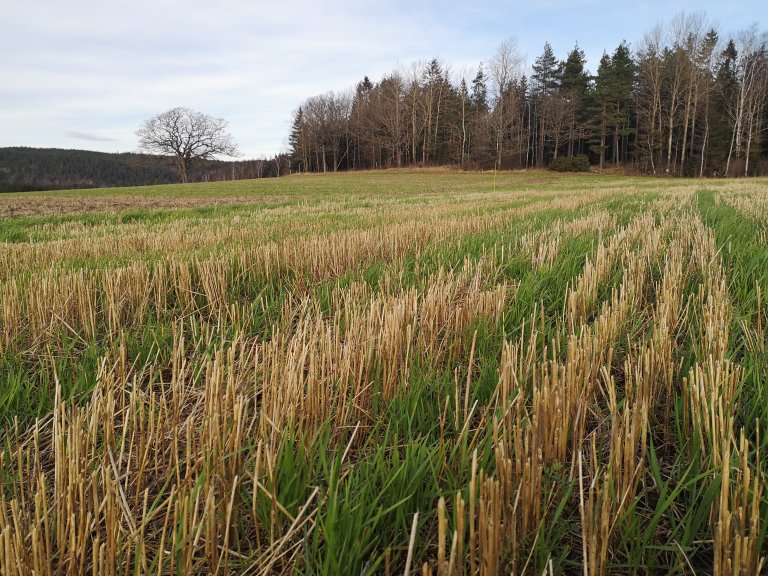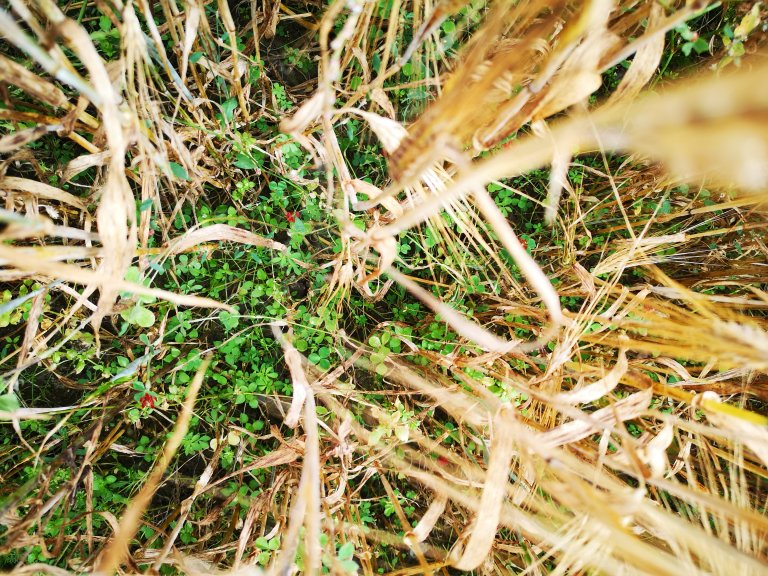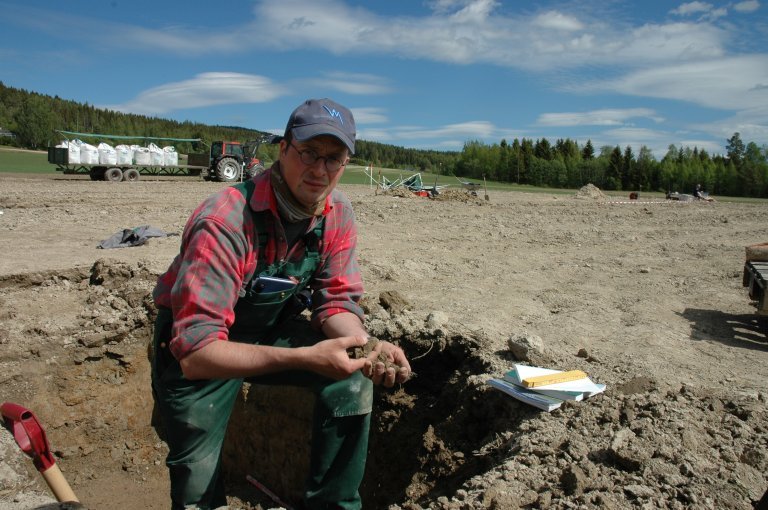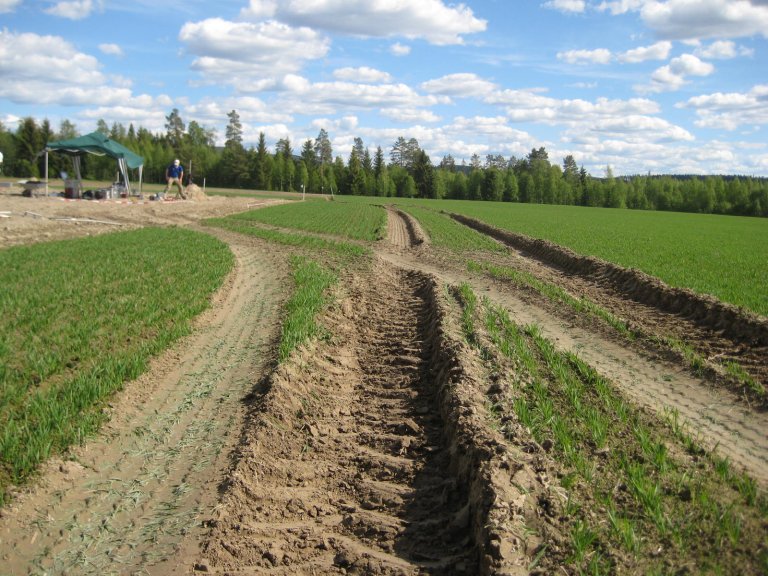
Blog (7)
News from the field: Improving soil quality in Norway
Written by Jane Mills - WP8
Over the last four years, researchers and agricultural advisers at SoilCare have examined what kind of measures are needed to make European agriculture more sustainable. The goal is to find solutions that are adapted to local climate and soil conditions and the socio-economic situation.
The population is increasing. It also puts pressure on land areas in several European countries, with increasing food production on declining land areas. To prevent depletion of the soil, local measures must be put in place that contributes to more sustainable agriculture.
In the European research project SoilCare, researchers have been working for several years to find solutions to the challenges facing our land resources. "Much of today's agricultural practice goes beyond the soil structure and soil composition, which in turn results in reduced soil quality", says Jannes Stolte, department manager at NIBIO and responsible for the SoilCare project from the Norwegian side. "By changing the way we operate the soil, we can stop the deterioration of soil quality. This is absolutely crucial if we are to be able to maintain, and preferably also increase, future food production".
Captive plants for improving soil quality
In Norway, NIBIO in collaboration with the Norwegian Agricultural Advisory Service (NLR East) has looked at how catch crops sown in open fields can contribute to increasing carbon content and overall soil quality. Field trials to find out if different plants with their root systems can dissolve in soil compaction damage have also been carried out.

NIBIO researcher Frederik Bøe is responsible for the capture growth experiments. He says that catch crops were seen internationally mainly to reduce nitrogen runoff. This is because catch crops that grow throughout the autumn absorb the nitrogen that is released from the soil after harvest. "In Norway, catch crops are also considered an important measure against particle-bound phosphorus runoff, as the plants protect the soil surface and the roots contribute to the soil remaining more stable than if it is bare", he says.
In the SoilCare context, Bøe has, among other things, investigated whether catch crops sown in areas with a lot of open fields can also increase the carbon content of the soil and contribute to better soil quality. "Captive plants add biomass to the soil, and thus contribute to increased carbon sequestration. The increased supply of plant residues can increase the activity of the microorganisms that live in the soil, which in turn can provide better soil structure and greater release of nutrients to the plants", he says.
Of the catch crops that were sown on the experimental field in Øsaker, capelin, ryegrass and clover did best.

Difficult weather conditions during the trial period
During the project period, Bøe and NLR Øst have had a small route experiment for catch growths going on at Øsaker in Østfold. It has proved difficult to establish a good catch growth cover in the area, much due to unusual heat and dry conditions in the summer of 2018.
"In addition to variations in the weather, the establishment and development of catch crops were negatively affected by both weeds and practical challenges that come with such a small experimental area", says Bøe. Of the catch crops that were sown, capelin, ryegrass and clover did best. However, the drought period seemed to have a negative effect on both the soil and the aquatic environment. "As the plant growth was generally poor, it may have led to a reduced carbon level in the experimental field as a result of a small supply of carbon through plant material to the soil", Bøe explains. "In addition, we saw an excess of nutrients in the soil as a result of the fertilizer not being absorbed by the plants, which poses a potential risk to the surrounding aquatic environment". The researcher points out that even though they had problems establishing a sufficient catch growth cover on the experimental area, this did not seem to be an equally big problem for nearby farms with catch growths. "Several of the farms achieved cover of catch growth in the following years after the drought in 2018. The fact that we had such poor growth on the experimental area, is probably partly due to the fact that the area we used was quite small", he says.
Plant roots can alleviate soil compaction
Tillage under unfavorable conditions can lead to soil compaction, which in turn can lead to reduced infiltration of water, increased surface runoff, more erosion and poorer conditions for plant growth. This is an ever-increasing challenge, especially in Norway where climate change leads to warmer temperatures with more precipitation. "In addition to finding the best possible practice to avoid soil compaction and increase soil stability to make the soil less sensitive, it is important to see if it is possible to dissolve existing soil compaction where the damage has already occurred", says NIBIO researcher Till Seehusen.
In collaboration with NLR Øst, he has carried out experiments to find methods for resolving soil compaction damage. Based on an earlier package experiment from 2015 at Solør-Odal, north of Kongsvinger, he built routes in 2017 with different growth shifts. The growth shifts included barley monoculture, crop rotation with oilseed rape and grain, and routes with the perennial herb lice. "The root system of turnips and lice can in theory help to dissolve the soil structure, so that the water infiltrates more easily and the grain has better growing conditions. We have not fully analyzed all the data, but preliminary results show that the lice worked quite well, while the oil growth of turnips did not have the effect we hoped for", the researcher says.
As for the catch growth experiment, the unusually dry growing season in 2018 followed by the extremely wet early summer of 2019 was challenging. "Rye is relatively robust and also has a large and efficient root system if it is established properly. Unfortunately, the establishment did not go quite as hoped. This is due to the special seasons with varying weather, but also that the growing season simply seems to be too short for turnips in Solør-Odal", says Seehusen. The fact that the route experiment was also visited by moose did not improve the situation. "In such small experimental areas, it is quite important when a huge elk steps through the experimental field", Seehusen says.
The experiments with the Lucerne that have now been going on for four years are more promising. "The alfalfa had plenty of time to establish itself and develop the root system, and we have achieved very good growth", says Seehusen. "It is very fun to dig in the alfalfa field. It has grown with strong roots, both downwards and in width". According to the researcher, the root system of the alfalfa has had a good effect on the soil structure. The roots have penetrated the compacted soil and formed pores. These give the soil better water conductivity and can help the growth of subsequent plants such as grain. "The plan now in 2021 is to investigate the after-effects of how dissolved soil that has been dissolved works for grain", Seehusen says. " However, it is a small snag", he adds: "In Norway, Lucerne does not have much market value beyond as feed for horses".
Even though the lucerne from a research point of view seems to be a success in resolving parcel damage, it can be costly for the farmers to cultivate it as they are not allowed to use the land for anything else while it is growing. That being said, there is not much cost associated with the actual establishment of growth. In addition to fertilizing with rhizobium bacteria in the first season, it grows on its own, the researcher points out. The alfalfa, with its strong roots, had a good effect on the soil structure.
Profitability is about more than production volume
When assessing sustainable measures against costs, many factors come into play. One thing that is certain, and that SoilCare is particularly concerned about, is that increased costs must not go beyond the farmer.
"The demand for high-quality foods, which do not adversely affect the environment, is increasing. We must find ways to maintain sustainable production while protecting our land resources and maintaining overall profitability", says Rudi Hessel at the University of Wageningen in the Netherlands and project manager for SoilCare.
The profitability Hessel is talking about is more than just production volume. "Profitability is not just about money, but is a balance between income and expenses. If we can reduce the costs of food production for the environment, for example by using less fertilizer and chemicals, the overall profitability of society as a whole will increase, even if the production level may fall slightly", he says. "Europe can afford a small fall in agricultural production, but it must not happen at the expense of farmers. Farmers simply have to get a better price for their products", he adds.

Photo above: Researcher Till Seehusen in NIBIO has carried out several studies on the consequences of soil compaction. In SoilCare, he investigates whether growths with strong root systems can contribute to resolving package damage.
Photos: Frederik Bøe,Till Seehusen, Jon Schärer, To Seehusen
Link to the original article in Norwegian.
Deep-rooting grass cultivars could contribute to flood risk management
Written by Chris Stoate - SS6Introducing grass leys into arable rotations has the potential to improve soil structure and organic matter. This has benefits to the arable rotation, but can also increase water infiltration rates during storms, with resulting benefits in terms of flood risk management at the catchment scale. Reduced runoff from agricultural catchments can also result in improved water quality and aquatic ecology.
In one of our replicated plot experiments in the EU funded SoilCare project, we selected five modern deep-rooting agricultural grass cultivars as being the most likely to create pathways for water to reach deep into the soil profile, rather than running off the surface. Each cultivar was represented as a 50% component of an otherwise standard ryegrass and clover mix, with control plots comprising this standard mixture alone. The whole area was grazed by sheep and cut for silage following standard practice, but in years three and four of the experiment, we fenced off a three-metre wide strip that was ungrazed and uncut.
Norwegian workshop on adopting SICS farm management
Written by Jane Mills - WP8
The 4th Norwegian stakeholder workshop took place at NIBIO’s office in Oslo on the 13th of March 2019. Twelve people participated all together; five from NIBIO and seven external stakeholders. These included farmers, the board leader of the National Farmers Union, advisory service representatives and a representative from the Royal Norwegian Society for Development.
The workshop started with an introduction by researcher Kamilla Skaalsveen and a presentation of the SoilCare project by Jannes Stolte as a general reminder and an update on the progress of the project since last stakeholder meeting. Frederik Bøe and Till Seehusen followed by providing an update from the two study sites (Solør-Odal and Øsaker) to inform the participants about activities and results from 2018 and experimental plans for 2019.
The participants were asked to describe the SICS being tested in the Norwegian study sites (cover crops in general and cover crops to alleviate compaction) and the expected benefits/impacts. Some of these included getting subsidies, improving yield via N input and both cutting costs and increasing income as a result as well as improving soil quality and carbon storage. Risks were associated with competition between cover crops and the main crop, pests and diseases increasing, and the need to apply glyphosate to kill off cover crops.
Developments in the German Study Site and creation of Applicability Maps
Written by Jane Mills - WP8 The German Study Site at the Tachenhausen research farm is investigating the effects of glyphosate in a cropping system with cover crops and reduced tillage without ploughing. The use of glyphosate is currently highly debated, with public opinion pushing towards prohibition of this herbicide. Currently, as conventional conservation agriculture systems depend on herbicide use for weed control, it is important to understand the effects of glyphosate on soil biology. It is also important to develop alternative management practices to eliminate its use in the event that it is banned. This conflict illustrates a common structural problem of farming in industrialised countries, requiring research projects and stakeholder panels to avoid polarisation and destructive dynamics.The German Study Site at the Tachenhausen research farm is investigating the effects of glyphosate in a cropping system with cover crops and reduced tillage without ploughing. The use of glyphosate is currently highly debated, with public opinion pushing towards prohibition of this herbicide. Currently, as conventional conservation agriculture systems depend on herbicide use for weed control, it is important to understand the effects of glyphosate on soil biology. It is also important to develop alternative management practices to eliminate its use in the event that it is banned. This conflict illustrates a common structural problem of farming in industrialised countries, requiring research projects and stakeholder panels to avoid polarisation and destructive dynamics.
The German Study Site at the Tachenhausen research farm is investigating the effects of glyphosate in a cropping system with cover crops and reduced tillage without ploughing. The use of glyphosate is currently highly debated, with public opinion pushing towards prohibition of this herbicide. Currently, as conventional conservation agriculture systems depend on herbicide use for weed control, it is important to understand the effects of glyphosate on soil biology. It is also important to develop alternative management practices to eliminate its use in the event that it is banned. This conflict illustrates a common structural problem of farming in industrialised countries, requiring research projects and stakeholder panels to avoid polarisation and destructive dynamics.The German Study Site at the Tachenhausen research farm is investigating the effects of glyphosate in a cropping system with cover crops and reduced tillage without ploughing. The use of glyphosate is currently highly debated, with public opinion pushing towards prohibition of this herbicide. Currently, as conventional conservation agriculture systems depend on herbicide use for weed control, it is important to understand the effects of glyphosate on soil biology. It is also important to develop alternative management practices to eliminate its use in the event that it is banned. This conflict illustrates a common structural problem of farming in industrialised countries, requiring research projects and stakeholder panels to avoid polarisation and destructive dynamics.
In the field experiment the four treatments consist of: cover crops and glyphosate application, cover crops without glyphosate application, glyphosate application without cover crops and no glyphosate with no cover crops. All four treatments are replicated four times (= 16 Plots) on 12m² plots.
News from the field: Portuguese Study Site Spring legume Open Day
Written by Jane Mills - WP8
The Portugal Study Site held an Open Day this April to show local farmers the progress of their SICS trials on green manures.
Green Manures
One SICS includes growing green manure to look at the effect on soil quality and was particularly well received by the farmers and technicians. The Open Day was perfectly timed for the full flowering of the legumes, which caused a very enthusiastic reaction from the participants. It was suggested that besides monitoring the change in soil quality, calculating the nutrient release of the legumes would be a good idea. This in turn would help calculate only the necessary amount of mineral fertilization needed for application. The hopes would be to cut both cost and reliance on chemicals.

Following the Open Day, the nutrient release was determined for 5 species of legumes: Pea, Yellow Lupin, Red Clover, Balansa Clover and Arrowleaf Clover. In addition to improving SOC and weed control, the green manures supply an average of 35%, 25% and 100% of the NPK extraction of the grain maize. A paper publishing these results was recently released (September 2019) in a national agricultural technical-scientific Journal.

Farmer Rafael Alonso Aguilera in his organic olive grove, with drip irrigation and cover crop SICS. Photo credit: Jasmine Black
In our second newsletter (November 2017), we introduced you to the two Spanish study sites, located in the South-East of Spain near Almeria – Area A in the Sorbas-Tabernas Basin and Area B in the Cabo de Gata Natural Park. Recently the SoilCare research team met in Almeria to discuss project progress and visit the two study sites

Piling up woodchip to be spread over the trial fields. Photo credit: BDB
In our third newsletter (September 2018), we introduced the Belgium study site in Flanders, which is running two different SICS trials. We now have some interesting preliminary findings from their first trial which uses ramial woodchip incorporated as a soil amendment to increase organic matter, soil biodiversity and soil quality in general. Initial results of woodchip applications are being compared to others including manure, food waste and bought-in compost.



